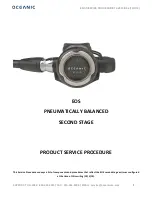
EOS SERVICE PROCEDURE 12-2810-R02 (10/3/10)
SUPPORT: TOLL‐FREE: 800‐435‐3483 | FAX: 510‐569‐5404 | EMAIL: [email protected]
13
7.
Pressurize
the
regulator
again
and
listen
for
leaks
or
air
flow;
none
should
be
present.
If
a
leak
is
present,
repeat
steps
3
through
5.
8.
Hold the second stage with the
Front Cover (2)
facing downwards; gently shake up and down, listening for any rattle
sound indicating excessive lever slack. If a rattle sound is found, readjust the
Orifice (26)
as outlined in steps 4 and 5.
9.
Inhalation Effort Test with Magnehelic Gauge & IP Gauge:
Attach the correctly adjusted second stage to a
*Magnehelic Gauge via the mouthpiece adapter; slowly inhale on the mouthpiece while watching the IP Gauge. The
moment
the
needle
of
the
IP
Gauge
moves
left
from
140
psi
indicating
the
precise
moment
the
first
stage
has
opened,
look
at
the
Magnehelic
Gauge
and
record
the
Inhalation
Effort
in
Inches
Water
Column
(IWC);
this
is
also
referred
to
as
Cracking
Effort.
Inhalation
Effort
is
not
to
exceed
1.2 IWC
.
*(Magnehelic is a registered trademark of Dwyer Instruments).
Fig. 46
10.
Inhalation Effort Test with Flowmeter:
Attach the correctly adjusted second stage to a flow meter that is connected
to a Magnehelic Gauge via the mouthpiece adapter
(Fig. 47)
. Initiate airflow through the flow meter with the needle
valve
while
watching
the
IP
Gauge.
The
moment
the
IP
Gauge
needle
moves
left
from
140
psi
indicating
the
precise
moment
the
first
stage
has
opened,
look
at
the
Magnehelic
Gauge
and
record
the
Inhalation
Effort
in
IWC.
Inhalation
effort
is
not
to
exceed
1.2 IWC
.
NOTE:
If
the
inhalation
effort
is
greater
or
less
than
specification,
refer
to
the
Trouble
shooting
section
on
page
3
to
determine
the
possible
cause
and
resolution.
Fig. 47
11.
Depressurize and remove the second stage from the Magnehelic Gauge. Attach a clean
Mouthpiece (8)
to the
mouthpiece tube
and secure
with a
Tie Wrap
(7)
.

















